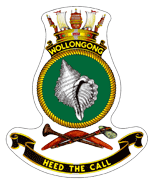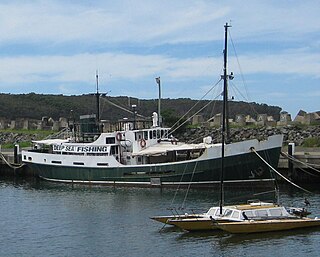Related Research Articles

HMAS Barcoo (K375/F375/A245) was a River-class frigate of the Royal Australian Navy (RAN). One of twelve frigates constructed in Australia during World War II, Barcoo, was laid down by Cockatoo Docks & Engineering Company, Sydney in 1942, and commissioned in early 1944.

HMAS Queenborough (G70/D270/F02/57) was a Q-class destroyer that served in the Royal Navy (RN) and Royal Australian Navy (RAN).
HMAS Archer was an Attack class patrol boat of the Royal Australian Navy (RAN).

HMAS Echuca (J252/M252), named for the town of Echuca, Victoria, was one of 60 Bathurst-class corvettes constructed during World War II, and one of 36 initially manned and commissioned by the Royal Australian Navy (RAN).

HMAS Stawell (J348/M348) was a Bathurst-class corvette named for the town of Stawell, Victoria. Sixty Bathurst-class corvettes were constructed during World War II, and Stawell was one of 36 initially manned and commissioned solely by the Royal Australian Navy (RAN).

HMAS Yarra, named for the Yarra River, was a River-class torpedo-boat destroyer of the Royal Australian Navy (RAN). Ordered in 1909 for the Commonwealth Naval Forces, Yarra was temporarily commissioned into the Royal Navy on completion in 1910 and handed over to Australian control on arrival in Australia.

HMAS Parramatta (U44) was a Grimsby class sloop of the Royal Australian Navy (RAN). Built during the late 1930s, Parramatta operated in the Red Sea and Mediterranean during World War II. The sloop was torpedoed by the German submarine U-559 on 27 November 1941, and sank with 138 of the 162 aboard.

HMAS Wollongong, named for the city of Wollongong, New South Wales, was one of fifteen Fremantle class patrol boats to operate with the Royal Australian Navy (RAN). Wollongong is the only RAN vessel to have appeared in two television series, portraying a fictional Fremantle class patrol boat in both.

HMAS Banks was an Explorer class general-purpose vessel of the Royal Australian Navy (RAN), serving in a range of capacities from 1960 until 1995. She was named in honour of Sir Joseph Banks, the botanist aboard HM Bark Endeavour during the discovery of the eastern coast of Australia in 1770.

The State Dockyard was a ship building and maintenance facility operated by the Government of New South Wales in Carrington, Newcastle, New South Wales, Australia between 1942 and 1987.

HMS Sealark was a Royal Navy vessel used primarily for hydrographic survey work. She was originally a luxurious private auxiliary steam yacht for a number of wealthy owners and in 1903 was acquired by the Royal Navy, serving until 1914. She was sold to James Patrick Steamships Ltd and converted to a merchant ship for the Australian coast and finally hulked in 1924.

The Explorer class was a two-ship class of general purpose vessels of the Royal Australian Navy that served between 1960 and 1995.
HMCS Spitfire was a 65-ton sail gunboat built at Cuthberts Shipyard, Port Jackson, Australia and launched on 3 April 1855 for the Colony of New South Wales. Her hull was sheathed with 22-ounce copper. She was the first warship built in Australia for a Colonial government. Spitfire was given to the Colony of Queensland in 1859 and she was used as the pilot cutter on Moreton Bay. In 1860, she was used as part of an expedition to find the mouth of the Burdekin River. She was to become the pilot boat for Cooktown, until sold out of service in 1885 and purchased by Captain Alex Mathewson, for use as a fishing vessel. She was sold in 1892 to Dan Moynahan and S.B. Andreassen and during a cyclone in 1896 she was damaged off Hinchinbrook Island.

TB 191 was a second-class torpedo boat constructed for the Colony of Tasmania and later operated by the Commonwealth Naval Forces and the Royal Australian Navy. She was sold in 1911.
Esturia was a 2,143 gross register ton oiler, built by Armstrong Whitworth & Company, Walker in 1910. She operated as an oil tanker for the Burmah Oil Company, before being chartered by the Royal Australian Navy on 11 September 1914, during the First World War, as an oiler and stores ship. She served as the destroyer depot ship for HMAS Swan, Huon, and Torrens in Australian and Malayan waters. After being dispatched to Port Said, Egypt with the destroyers, she was transferred to the Admiralty.

Whangape was a cargo ship measured at 2,931 gross register tons (GRT), built in 1899 by Sir Raylton Dixon & Co., Middlesbrough. The vessel was constructed for the British Maritime Trust as Adriana, sold while on the slips to Elder, Dempster & Company and renamed Asaba. Her engine was built by T Richardson & Sons, Hartlepool.
HMAS Coogee was a passenger ferry that briefly served as a Royal Australian Navy armed patrol vessel and minesweeper in the latter part of the First World War. She was launched in 1887 and scuttled in 1928.

HMAS Bass was an Explorer class general-purpose vessel of the Royal Australian Navy (RAN), serving in a range of capacities from 1960 until 1994.

BRP Ivatan (LC-298) is a Balikpapan-class heavy landing craft operated by the Philippine Navy. One of eight vessels built by Walkers Limited for the Royal Australian Navy (RAN), the ship was commissioned into Australian service in 1973 as HMAS Brunei. During her RAN career, Brunei visited Lord Howe Island, was deployed post-Cyclone Tracy as part of Operation Navy Help Darwin, performed coastal surveys of northern Australia and Papua New Guinea, and served as part of the INTERFET peacekeeping taskforce.

BRP Batak (LC-299) is a Balikpapan-class heavy landing craft operated by the Philippine Navy. One of eight vessels built by Walkers Limited for the Royal Australian Navy (RAN), the ship was commissioned into Australian service in 1973 as HMAS Tarakan. During her RAN career, Tarakan was deployed post-Cyclone Tracy as part of Operation Navy Help Darwin, undertook various surveying operations, was placed in reserve between 1985 and 1988, relocated an overpopulation of Tridacna gigas clams, was part of the INTERFET peacekeeping taskforce, and participated in a Pacific Partnership humanitarian deployment.
References
- Gillett, Ross (1986). Australia's navy: past, present & future. Brookvale, NSW: Child & Henry. ISBN 0-86777-178-X.
- Odgers, George (1982). The Royal Australian Navy: an illustrated history. Brookvale, NSW: Child & Henry. ISBN 0-86777-240-9.